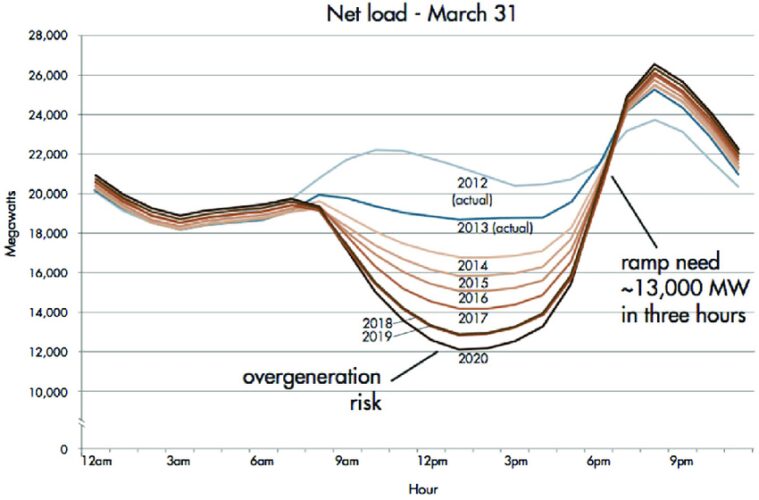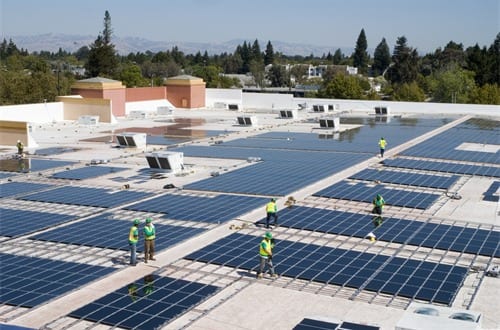The “Duck Curve” was recognised as a worrying phenomenon when the California Independent System Operator (CAISO) first published a report in 2013 that predicted the impact of (mostly) solar generation on the net load.
The chart (below) showed the variations in the demand net of variable renewables, such as solar, during a typical sunny day.
For those familiar with dispatching generation and balancing supply and demand, the Duck Curve highlighted the challenges associated with a growing solar resource that results in net demand being reduced during the day, the duck’s belly, and sharply increasing at sunset, the duck’s neck.

The phenomenon, which was already evident in 2012, was projected to get progressively worse over time with the evening ramps expected to reach 13 GW by 2020.
As it happened, CAISO was spot on in predicting the vanishing mid-day net load and increased evening ramps, but it under-estimated how soon and how serious the consequences would be.
At 1:10 pm on a recent cool and sunny Sunday 21 April 2023, CAISO’s net load was -203 MW – that is negative 203 MW – while the evening 3-hour ramp was 17,141 MW.
On a blog posted on the professional social network Electricity Brain Trust (EBT), CEO of the Electric Power Research Institute (EPRI), Arshad Mansoor, wrote, “The duck now looks like a canyon.”
“The canyon is getting deeper, and this has repercussions in sharply reducing dispatchable resources during the daytime and then conversely increasing the need for flexibility as the sun sets. This is an example of the canyon curve.”
“This means energy companies will need to switch off resources that cannot turn on quickly to get out over the canyon during sunset, or else they must curtail the solar, wasting zero-cost, clean energy. The canyon walls are also getting steeper, meaning energy companies need more flexibility from the reduced set of resources left.”
“Today, the descent into the canyon is done largely through reducing gas generation output, transitioning from importing to exporting power, and charging batteries.”
“To climb the walls, some gas generation must remain online, even at the canyon floor.”
The consequences of the progressively worsening daily cycles are evident to those who know what it takes to keep the supply and demand in balance.
“The full climb requires ramping up gas generation as the sun sets, exports switching to electricity imports, additional hydroelectric generation being released from reservoirs, and batteries using the energy it charged on the canyon floor, to full out discharge,” Mansoor wrote.
“In the future, other resources may be required to fill in the canyon and scale the walls including time-of-use rates and other programs that encourage electricity usage from the evening to midday; additional forms of energy storage (thermal, mechanical, chemical, etc.) that can transfer energy to when it is needed; and new technologies like hydrogen with flexible new electrolyzers.”
Few would disagree that as an industry, a lot needs to be done in response to the daily cycles of solar feast and famine – wind also has its variability challenges but not as serious as solar, especially in solar-dominated networks such as CAISO.
One obvious solution, already introduced, is the expansion of CAISO’s energy imbalance market, which helps manage this situation through economic sharing of resources with California’s neighbors in the Western Electric Coordination Council (WECC). The implementation of enhanced day-ahead market or EDAM should also help.
The expansion of CAISO’s physical footprint to include some or all of WECC region would also facilitate the integration of variable generation and flexible loads into a single wholesale market.
An earlier study suggested that an expanded Western EDAM could save as much as $1.2 billion per year.
There are, of course, no shortages of other ideas, basically anything that could either absorb and/or store the abundant solar generation during the sunny hours and release it back during the evening ramp periods including:
- Charging the batteries of millions of electric vehicles;
- Batteries of any kind including storing hot or chilled water, precooling buildings prior to the evening ramp period;
- Pumped hydro-storage;
- Developing more demand flexibility; and
- Using the excess solar to make green hydrogen, desalinating water, etc.
According to Andrew Blakers, a professor at the Australian National University (ANU) in Canberra, Australia, storage is a solved problem.
His favourite technology is pumped hydro storage, a mature technology that is proven, cost-effective and available nearly everywhere – so long as there are two reservoirs with sufficient difference in elevation. No river or dam required.
He says there is virtually no limit to how much energy can be stored with relatively little loss in turnaround efficiency.
And unlike batteries, pumped hydro storage can store vast amounts of energy for hours, days, week, months or even years with little loss aside from evaporation.
While there may be disagreements on what is the best, cheapest, and most readily available option, there
is no disagreement that a lot needs to be done to address the inevitable variability of renewable resources,
and not just in California.
Fereidoon Sioshansi is editor and publisher of EEnergy Informer, and president of Menlo Energy Economics.








